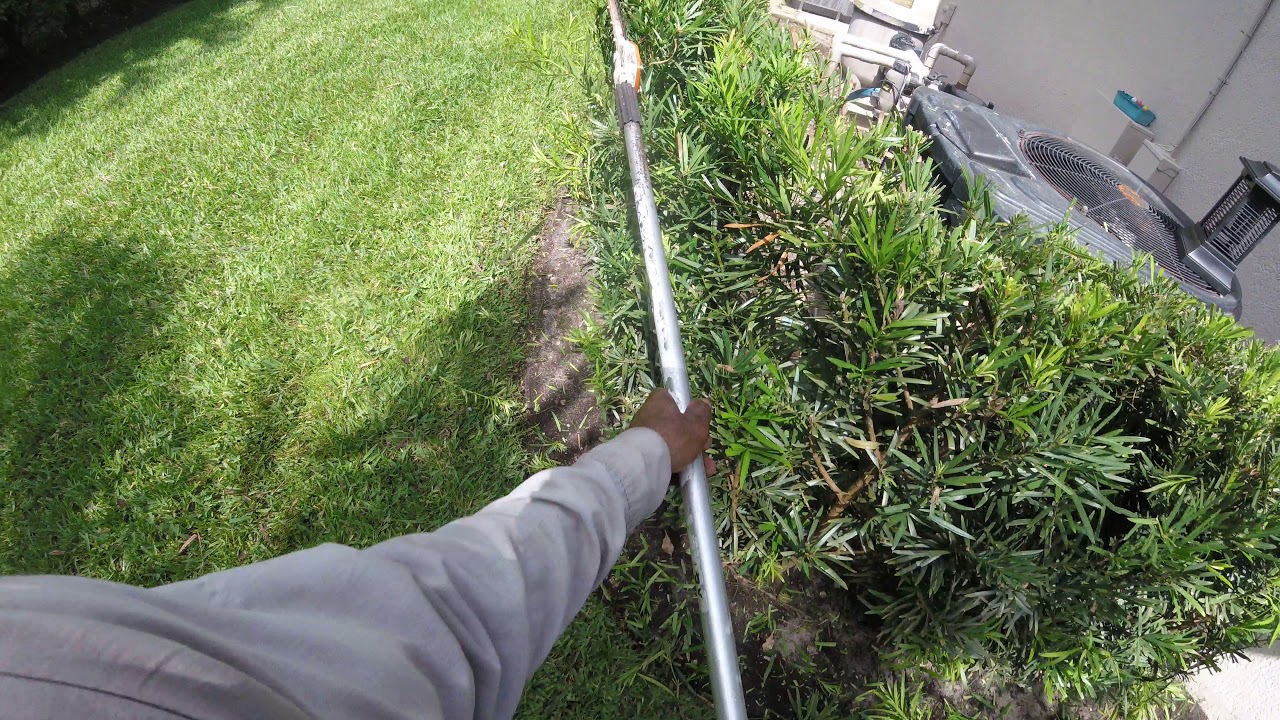To trim Podocarpus, use sharp pruning shears and make clean cuts just above a healthy bud or branch. First, remove any dead or diseased branches, then carefully shape the plant by selectively trimming back long or unruly stems.
Keep in mind that Podocarpus can tolerate heavy pruning, but avoid removing more than one-third of the plant’s total foliage at once to avoid stress. Regularly maintaining and shaping the plant will help promote healthier growth and a more compact appearance.
A well-trimmed Podocarpus not only enhances its aesthetic appeal but also keeps it in a manageable size for your space.

Credit: leafyplace.com
Tools Required For Trimming Podocarpus
To effectively trim podocarpus, you will need a few essential tools. Pruning shears are necessary for cutting smaller branches and twigs. Hedge trimmers come in handy for shaping and trimming larger sections of the plant. A ladder is required to reach higher areas, ensuring you can prune the entire podocarpus evenly.
Don’t forget to wear safety goggles to protect your eyes from debris and sharp branches. Additionally, gloves are essential to safeguard your hands from scratches and potential allergic reactions. By having these tools at your disposal, you’ll be well-equipped to maintain the health and appearance of your podocarpus plant.
Keep in mind that regular trimming promotes growth and allows for proper air circulation within the plant, fostering its overall well-being.
Timing And Frequency For Trimming Podocarpus
Timing and frequency are crucial when it comes to trimming podocarpus. Trimming should be done during the dormant season. The best time is late winter or early spring. This allows the plant to recover quickly and promotes healthy growth. It is important to avoid pruning during extreme weather conditions, such as freezing temperatures or scorching heat.
As for frequency, podocarpus generally requires trimming once or twice a year. However, the ideal frequency will depend on the growth rate and desired shape of the plant. Regular pruning helps maintain its appearance and prevents overgrowth. When trimming, focus on removing dead or damaged branches, as well as shaping the overall structure.
Following these guidelines will ensure a beautiful and well-maintained podocarpus.
How to Trim Podocarpus: Step by Step Guide
Assessing The Health Of The Plant
Assessing the health of the plant is crucial when it comes to trimming Podocarpus. To ensure proper pruning, it is important to identify dead or diseased branches. Inspecting the plant thoroughly will help determine overgrown areas that need attention. By removing these overgrown parts, you can promote healthy growth and maintain the desired shape of the plant.
Trimming should be done carefully, considering the natural form of the Podocarpus. Regular assessment and proactive pruning will not only enhance the plant’s aesthetics but also improve its overall health. Paying attention to the plant’s condition and addressing any issues promptly will keep your Podocarpus thriving for years to come.
Pruning Techniques For Podocarpus
Podocarpus is a versatile plant that can be trimmed through various pruning techniques. By selectively pruning, you can promote healthy growth and achieve the desired shape or form. Pruning also helps in controlling the size and density of the plant.
To trim Podocarpus effectively, start by removing any dead or damaged branches. This not only improves the plant’s appearance but also prevents the spread of diseases. Additionally, thinning out crowded branches allows better air circulation and reduces the risk of pests and fungal infections.
Regular pruning stimulates new growth and keeps the plant compact and manageable. Remember to use sharp and clean tools to make clean cuts and avoid any unnecessary stress to the plant. With the right techniques, your Podocarpus can thrive and enhance the beauty of your garden.
Proper Cutting Techniques For Pruning Podocarpus
Proper cutting techniques are essential for pruning Podocarpus to prevent damage or disease. When trimming, it is crucial to make clean cuts that are not too close to the trunk or main branches. This helps maintain the tree’s health and appearance.
Additionally, removing the correct amount of foliage is important to promote new growth and maintain the desired shape. By following these guidelines, you can ensure that your Podocarpus stays healthy and vibrant. Proper pruning techniques will not only enhance the overall appearance of your tree but also prolong its lifespan.
Take the time to trim your Podocarpus with care and precision, and you will be rewarded with a beautiful and thriving tree.
Mulching And Fertilization
Mulching around Podocarpus provides several benefits. It helps retain moisture in the soil, preventing evaporation. Mulch also acts as an insulator, protecting the roots from extreme temperatures. Additionally, it suppresses weed growth, reducing competition for nutrients. The organic matter slowly decomposes, enriching the soil with nutrients.
Furthermore, mulch improves the soil structure, promoting better drainage and aeration. It also prevents soil erosion, keeping the roots firmly anchored. When it comes to fertilization, using the right practices is crucial for optimal growth. A balanced fertilizer with a ratio of nitrogen, phosphorus, and potassium supports healthy development.
Regularly monitoring soil pH and adjusting fertilization accordingly ensures a favorable environment for Podocarpus. By implementing proper mulching and fertilization, you can promote the overall health and vigor of your Podocarpus plants.
Watering And Sunlight Requirements
Providing adequate water after trimming is crucial for the healthy growth of your Podocarpus. Ensure that you water the plant deeply, allowing the soil to absorb moisture thoroughly. Allow the soil to dry slightly between waterings to prevent overwatering. As for sunlight requirements, Podocarpus plants thrive in bright, indirect light.
Place them near a sunny window where they can receive at least 4-6 hours of sunlight per day. Avoid placing them in direct sunlight as it can scorch the leaves. Monitor the plant’s response to sunlight and adjust its placement accordingly.
By following these watering and sunlight guidelines, you can ensure your trimmed Podocarpus continues to thrive and enhance the aesthetics of your space.
Monitoring And Pest Control
Regularly inspect your Podocarpus plants for any signs of pests or diseases. Prevention is key, so take necessary measures to avoid infestations. Carefully monitor the leaves, branches, and trunks of the plants. Look out for any discoloration, spots, or unusual patterns.
Keep an eye on the growth and overall health of the plants, as pests and diseases can cause stunted growth or wilting. If you notice any issues, act promptly to address them. Consider using natural or organic pest control methods, avoiding harsh chemicals that could harm the environment.
Regularly clean and maintain the area around the plants to discourage pests from taking residence. By consistently monitoring and taking preventive actions, you can keep your Podocarpus plants healthy and pest-free.
Frequently Asked Questions On How To Trim Podocarpus
When Should I Trim Podocarpus?
Trim your podocarpus when it becomes overgrown or to maintain its desired shape.
How Do You Prune An Overgrown Podocarpus?
To prune an overgrown podocarpus, cut back excessive growth with clean, sharp pruning shears, focusing on removing one-third of the branches at a time.
How Do You Prune Podocarpus In Florida?
To prune podocarpus in Florida, carefully trim the branches in a way that encourages healthy growth.
Can Podocarpus Be Shaped?
Yes, podocarpus can be shaped according to your desired look.
Conclusion
Trimming podocarpus is an essential task for maintaining the health and appeal of these versatile plants. With the right tools and techniques, you can achieve the desired shape and size while promoting new growth. It is important to assess the specific needs of your podocarpus and understand its growth habits before starting the trimming process.
Regular pruning can help prevent diseases and maintain the overall structure of the plant. Remember to trim during the appropriate season and avoid excessive pruning to avoid stress on the plant. By following the step-by-step guide outlined in this blog post, you can confidently trim your podocarpus and enjoy a thriving, beautiful plant in your garden or landscape.
Happy trimming!

